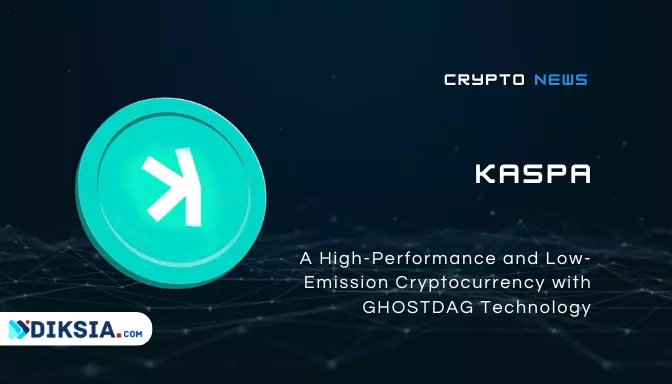However, a DAG also poses a challenge for achieving consensus, as there is no clear way of determining the order of blocks and transactions in the network. This is where GHOSTDAG comes in. GHOSTDAG is a protocol that assigns a unique order to the blocks in the DAG, using a combination of two rules: the blue rule and the red rule. The blue rule selects the blocks that have the most accumulated proof-of-work behind them, forming a virtual chain of blocks called the blue set. The red rule selects the blocks that are not in the blue set, but are directly or indirectly referenced by the blue set, forming a complementary set of blocks called the red set. Together, the blue set and the red set form the GHOSTDAG order, which is the canonical order of the blocks and transactions in the network.
By using GHOSTDAG, Kaspa can achieve a high level of security and finality, as the blocks in the blue set are unlikely to be reverted, and the blocks in the red set are also confirmed by the blue set. Moreover, Kaspa can achieve a high level of scalability and efficiency, as the blocks in the DAG can be created and validated at a very high rate, and the block data can be pruned to save storage space.
Who Are the Founders of Kaspa?
Kaspa was envisioned by R&D company DAGLabs, through investment by PolyChain. Nonetheless, Kaspa is a community project, completely open source, no central governance, and no business model. The founder is Yonatan Sompolinsky, Postdoc CS at Harvard University on the MEV Research Team. Yonatan’s 2013 paper on Ghost protocol is cited in the Ethereum Whitepaper. Kaspa core developers and contributors include Cryptography Doctoral student Shai Wyborski, CS Master Michael Sutton, Mike Zak CS Undergrad Studies, Cryptography researcher Elichai Turkel, and Developer Ori Newman – all of whom contributed immensely to the implementation and stabilization of the network.
Why is Kaspa important?
Kaspa is important because it offers a new paradigm for cryptocurrency design and innovation. By using GHOSTDAG, Kaspa can overcome the limitations of traditional blockchains, such as low throughput, high latency, and high emissions. Kaspa can support a large number of transactions per second, with minimal confirmation times and emissions, making it suitable for various use cases and applications that require fast and cheap transactions. Kaspa can also enable new possibilities for layer 2 solutions, such as subnetworks, which can further enhance the scalability and functionality of the network. Kaspa is also important because it is a community-driven project, with no pre-mine, no ICO, no central authority, and no profit motive. Kaspa is open to anyone who wants to participate, contribute, and benefit from its development and growth.
What Makes Kaspa Unique?
Kaspa is unique in several ways. First, Kaspa is unique in its use of GHOSTDAG, which is a novel and innovative protocol that combines the best of both worlds: the security of proof-of-work and the scalability of DAG. GHOSTDAG allows Kaspa to achieve a high level of performance and reliability, without compromising on decentralization and fairness. Second, Kaspa is unique in its monetary policy, which is based on the 12-note scale of music. This policy creates a smooth and predictable emission curve, which reduces the inflation rate and the supply shock over time. The policy also creates a connection between Kaspa and music, which is a universal language and a source of inspiration and creativity. Third, Kaspa is unique in its community and culture, which is open, inclusive, and collaborative. Kaspa is not controlled by any entity or organization, but by its users and developers, who share a common vision and passion for the project.
What are the key features of Kaspa?
Some of the key features of Kaspa are:
- High block rate: Kaspa can produce one block per second, and aims to increase it to 10 or even 100 blocks per second in the future. This means that transactions can be confirmed faster and more frequently, improving the user experience and the network capacity.
- Low confirmation time: Kaspa can achieve finality in seconds, as the blocks in the DAG are ordered and confirmed by the GHOSTDAG protocol. This means that users do not have to wait for long periods of time to ensure that their transactions are irreversible and secure.
- Low emission: Kaspa has a low and decreasing emission rate, as the block reward is reduced every month by a factor of (1/2)^(1/12). This means that Kaspa is environmentally friendly and sustainable, as it consumes less energy and resources than other proof-of-work cryptocurrencies.
- Block data pruning: Kaspa can prune the block data, which is the payload of the blocks that contains the transactions and other information. This means that Kaspa can save storage space and bandwidth, as the nodes do not have to store and transmit the entire history of the network.
- SPV proofs: Kaspa can generate SPV (simplified payment verification) proofs, which are compact proofs that a transaction is included in a block. This means that Kaspa can support light clients, which are nodes that do not have to download and validate the whole network, but can still verify transactions and participate in the network.
- Subnetwork support: Kaspa can support subnetworks, which are subgraphs of the DAG that have their own rules and logic. This means that Kaspa can enable layer 2 solutions, such as sidechains, sharding, and state channels, which can further improve the scalability and functionality of the network.
History
How did Kaspa come about?
Kaspa was born out of the research and development of DAGLabs, a company that specializes in DAG-based technologies and solutions. DAGLabs was founded in 2017 by Yonatan Sompolinsky, who is also the founder of Kaspa and the co-author of the GHOSTDAG protocol. DAGLabs received funding from PolyChain, a leading cryptocurrency investment firm, to pursue its vision of creating a high-performance and low-emission cryptocurrency based on GHOSTDAG. In 2018, DAGLabs released the first version of the Kaspa whitepaper, which outlined the technical details and the design goals of the project. In 2019, DAGLabs launched the Kaspa testnet, which allowed the community to test and experiment with the network and its features. In 2020, DAGLabs announced the Kaspa mainnet launch, which took place on May 7th. 2021, after a successful audit by Trail of Bits, a leading security firm. Since then, Kaspa has been growing and evolving, with the support and participation of its community and partners.
What is the development roadmap for Kaspa?
Kaspa has a dynamic and ambitious development roadmap, which reflects its vision and goals. Some of the main milestones and features that Kaspa plans to implement in the near future are:
- Block header pruning: Kaspa will implement a mechanism to prune the block headers, which are the metadata of the blocks that contain the hash, the timestamp, the difficulty, and the references to other blocks. This will further reduce the storage and bandwidth requirements of the network, and enable faster synchronization and validation of the nodes.
- Subnetworks: Kaspa will introduce subnetworks, which are subgraphs of the DAG that have their own rules and logic. Subnetworks will allow users to create and join different types of layer 2 solutions, such as sidechains, sharding, and state channels, which can offer more scalability, functionality, and privacy for the network.
- Smart contracts: Kaspa will enable smart contracts, which are self-executing programs that can encode and enforce complex rules and logic on the network. Smart contracts will allow users to create and interact with various decentralized applications, such as decentralized exchanges, lending platforms, gaming platforms, and more.
- Governance: Kaspa will implement a governance system, which will allow the community to propose and vote on changes and improvements to the network. Governance will ensure that Kaspa remains adaptive and responsive to the needs and preferences of its users and developers.
Who are the key people behind Kaspa?
Kaspa is a community-driven project, which means that it is not owned or controlled by any single entity or organization, but by its users and developers, who share a common vision and passion for the project. However, there are some key people who have played a significant role in the creation and development of Kaspa, such as:
- Yonatan Sompolinsky: He is the founder of Kaspa and the co-author of the GHOSTDAG protocol. He is also the founder and CEO of DAGLabs, the company that initiated and funded the Kaspa project. He is a postdoctoral researcher at Harvard University, where he works on the MEV Research Team. He is an expert in blockchain and DAG technologies, and has published several papers on the topic, including the GHOST protocol, which is cited in the Ethereum whitepaper.
- Shai Wyborski: He is the lead developer and contributor of Kaspa. He is a doctoral student in cryptography at Bar-Ilan University, where he works on the DAGLabs Research Team. He is also a co-author of the GHOSTDAG protocol, and has extensive experience in software engineering and development.
- Michael Sutton: He is a developer and contributor of Kaspa. He is a master’s student in computer science at Bar-Ilan University, where he works on the DAGLabs Research Team. He is also a co-author of the GHOSTDAG protocol, and has a strong background in mathematics and programming.
- Mike Zak: He is a developer and contributor of Kaspa. He is an undergraduate student in computer science at Bar-Ilan University, where he works on the DAGLabs Research Team. He is also a co-author of the GHOSTDAG protocol, and has a keen interest in blockchain and DAG technologies.
- Elichai Turkel: He is a researcher and contributor of Kaspa. He is a doctoral student in cryptography at Bar-Ilan University, where he works on the DAGLabs Research Team. He is also a co-author of the GHOSTDAG protocol, and has a deep knowledge of cryptography and security.
- Ori Newman: He is a developer and contributor of Kaspa. He is a software engineer at DAGLabs, where he works on the Kaspa project. He is also a co-author of the GHOSTDAG protocol, and has a rich experience in software development and testing.
Technology
What is the underlying technology of Kaspa?
The underlying technology of Kaspa is the GHOSTDAG protocol, which is a novel and innovative protocol that orders the blocks in a DAG (directed acyclic graph) structure. A DAG is a network of nodes that have edges pointing in one direction, forming a tree-like structure without cycles. Unlike a blockchain, which is a linear chain of blocks, a DAG can have multiple branches of blocks that are created in parallel by different miners. This allows for higher throughput and lower latency, as transactions can be confirmed faster and more frequently.






